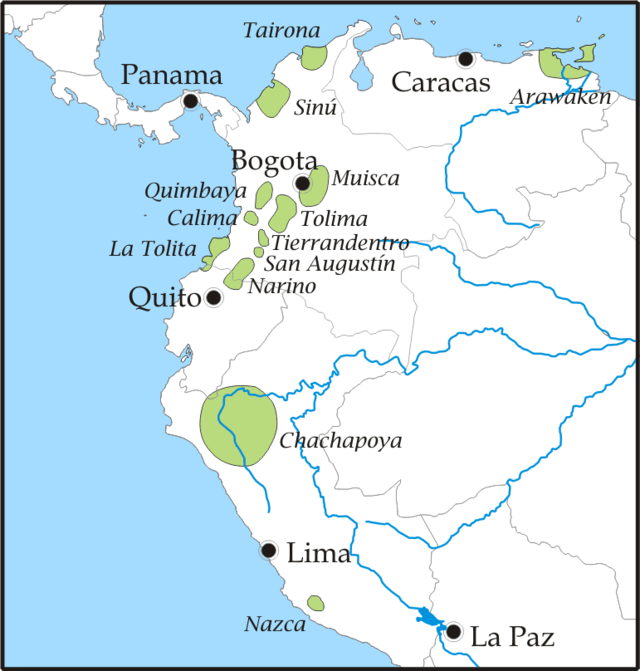The Nazca civilization flourished on the southern coast of Peru between 200 BCE and 600 CE. They settled in the Nazca and other surrounding valleys with their principal religious and urban sites being Cahuachi and Ventilla, respectively. The culture is noted for its distinctive pottery and textiles, and perhaps above all, for the geoglyphs made on the desert floor commonly known as Nazca lines. These can be simple lines, cleared spaces, or animals and figures traced in outline, and, as they cover several kilometres, they are best appreciated from the air.
OVERVIEW
The Nazca were contemporary with, and then outlasted, the Paracas culture and many Paracas sites have been discovered beneath Nazca settlements. Politically, the Nazca civilization has been described as a collection of chiefdoms occasionally acting in unison for mutual interest rather than as a single unified state. Or as M.E. Moseley puts it, "individuality - with cultural coherence, but without large-scale or integrated power - were Nazca hallmarks". This interpretation is reinforced by the art and architecture of the Nazca which displays common themes across settlements but at the same time there is a general lack of uniform town planning or evidence of centralization. The maximum population of the Nazca has been estimated at 25,000 people, spread across small villages which were typically built on terraced hillsides near irrigated floodplains.
As they developed, the Nazca extended their influence into the Pisco Valley in the north and the Acari Valley in the south. In addition, as llamas, alpaca and vicuna do not survive in the coastal areas the use of their wool in Nazca textiles is evidence that trade was established with highland cultures. In addition, Nazca mummies have been discovered wearing headdresses made with the feathers of rainforest birds, once again, illustrating that goods were traded across great distances.
Graves, often placed up to 4.5 metres deep and accessed via a shaft, are the richest source of Nazca artefacts and reveal many aspects of the culture. Fine pottery and textiles were buried with the dead and with no particular distinction between male and female burials. The deceased is mummified, carefully wrapped in textiles and usually placed in a seated position, skulls sometimes display deliberate elongation, and we know the Nazca wore tattoos. Tombs, especially shaft ones lined with mud bricks, could be re-opened and more mummies added, perhaps indicating ancestor worship. Caches of trophy-heads often accompany the mummy, many showing signs of trephination which allowed several to be strung on a single cord as illustrated in pottery designs. Trophy-heads are also frequently incorporated into textile designs, especially in miniature and as border decoration. There were also burials of what appear to be sacrificial victims. These have the eyes blocked and excrement was placed in the mouth which was then pinned shut with cactus needles. Alternatively, the tongue was removed and kept in a cloth pouch.
Weakened by a generation-long drought in the 5th century CE, the Nazca were eventually conquered by the Wari - who assumed many of their artistic traits - and Nazca settlements, thereafter, never rose beyond provincial status.
VENTILLA
Ventilla was the Nazca urban capital and covered over 2 square kilometres (495 acres) and included ceremonial mounds, walled courts, and terraced housing. To fight the ever-present threat of drought the Nazcans built an extensive network of underground aqueducts, galleries, and cisterns in order to ensure a good water-supply during the dry season and minimize evaporation. These were reached by impressive descending spiral ramps and lined with river cobbles.
CAHUACHI
Founded c. 100 BCE, Cahuachi, on the south bank of the Nazca River, 50 km inland, was a site of pilgrimage and the Nazca religious capital. It was probably first considered sacred because it was one of the few locations with a guaranteed year-round water supply. The lack of domestic architecture indicates it was not used as a place of habitation.
The sacred site covers 11.5 square kilometres (2,841 acres) and has around 40 large adobe mounds which take advantage of natural hills. The largest mound, known as the Great Temple, is over 20 metres high. All of the mounds have an adjoining plaza and are topped by adobe walls. The largest plaza measure 47 x 75 metres. A lowwall, 40 cm high, surrounded the main sacred precinct. Posts and postholes across the site suggest canopies protected worshippers from the sun. Textile scenes also suggest that religious gatherings were connected to harvest festivals, and piles of rubbish consisting mostly of pottery shards at the site indicate ritual feasting. This rubbish was deliberately left so that it became a part of the mound. Consequently, the larger the mound, the more it had been used in rituals. Some mounds also contained burials and large pots containing fine textiles given as religious offerings.
More details of the religious ceremonies that may have been carried out at Cauachi are depicted in Nazca art, especially on pottery, and many are scenes involving shamans. These religious figures, in a drug-induced trance, appealed to nature spirits to guarantee favourable conditions for agricultural abundance. Music was an important part of these rites, as is evidenced by the abundance of ceramic drums and panpipes in the archaeological record. The principal Nazca god seems to have been the Oculate Being who is represented in art as a flying deity figure wearing strings of trophy-heads. He is frequently depicted in pottery and textile designs in a horizontal position with streamers flowing from his body. Large staring eyes and a snake-like tongue are other typical features.

